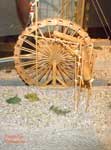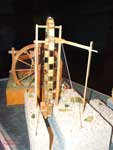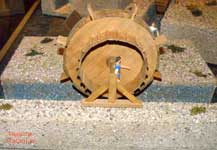.
Philon of Byzantium (Greek: Φίλων ο Βυζάντιος, ca. 280 BCE - ca. 220 BCE), also known as Philo Mechanicus, a Greek writer on mechanics, flourished during the latter half of the 2nd century B.C. He was probably younger than Ctesibius, though some place him a century earlier.
Philon was the author of a large work, Mechanike syntaxis (Compendium of Mechanics), which contained the following sections:
* Isagoge - an introduction to mathematics.
* Mochlica - on general mechanics.
* Limenopoeica - on harbour building.
* Belopoeica - on artillery.
* Pneumatica - on devices operated by air or water pressure.
* Automatiopoeica - on mechanical toys and diversions.
* Poliorcetica - on siegecraft
* Peri Epistolon - on secret letters
The military sections Belopoeica and Poliorcetica are extant in Greek, detailing missiles, the construction of fortresses, provisioning, attack and defence, as are fragments of Isagoge and Automatiopoeica (ed. R. Schone, 1893, with German translation in Hermann August Theodor Köchly's Griechische Kriegs-schriftstelle, vol. i. 1853; E. A. Rochas d'Aiglun, Poliorcetique des Grecs, 1872).
Another portion of the work, on pneumatic engines, has been preserved in the form of a Latin translation (De ingeniis spiritualibus) made from an Arabic version (ed. W. Schmidt, with German translation, in the works of Heron of Alexandria, vol. i., in the Teubner series, 1899; with French translation by Rochas, La Science des philosophes... dans l'antiquité, 1882). Further portions probably survive in a derivative form, incorporated into the works of Vitruvius and of Arabic authors.
The Philon line, a geometric construction that can be used to double the cube, is attributed to Philo.
The treatise De septem mundi miraculis, on the Seven Wonders of the World, attributed to Philo of Byzantium, but probably belongs to the 6th century A.D. It is printed in R. Hercher's edition of Aelian (Teubner, 1858).
Devices
Washstand automaton working with an escapement mechanism[1]
According to recent research, a section of Philo's Pneumatics which so far has been regarded as a later Arabic interpolation, includes the first description of a water mill in history,[2] placing the invention of the water mill in the mid-third century B.C. by the Greeks.[3]
Philon's works also contain the oldest known application of a chain drive in a repeating crossbow. Two flat-linked chains were connected to a windlass, which by winding back and forth would automatically fire the machine's arrows until its magazine was empty.[4]
Philon also was the first to describe a gimbal: an eight-sided ink pot with an opening on each side could be turnt so that any face is on top, dip in a pen and ink it-yet the ink never runs out through the holes of the side. This was done by the suspension of the inkwell at the center, which was mounted on a series of concentric metal rings which remained stationary no matter which way the pot turns itself.[5]
In his Pneumatics (chapter 31) Philon describes an escapement mechanism, the earliest known, as part of a washstand.[1] A counterweighted spoon, supplied by a water tank, tips over in a basin when full releasing a pumice in the process. Once the spoon has emptied, it is pulled up again by the counterweight, closing the door on the pumice by the tightening string. Remarkably, Philon's comment that "its construction is similar to that of clocks" indicates that such escapements mechanism were already integrated in ancient water clocks.[1]
Mathematics
In mathematics, Philon tackled the problem of doubling the cube. The doubling of the cube was necessitated by the following problem, given a catapult, construct a second catapult that is capable of firing a projectile twice as heavy as the projectile of the first catapult. His solution was to find the point of intersection of a rectangular hyperbola and a circle, a solution that is similar to Heron's solution several centuries later.



Automata Philon of Byzantium, Hydraulic wheel of Philon (Polykadia), The chained pump of Philon,

The sub-divided wheel of Philon ,
See also
* Chain pump
References
1. ^ a b c Lewis, Michael (2000), "Theoretical Hydraulics, Automata, and Water Clocks", in Wikander, Örjan, Handbook of Ancient Water Technology, Technology and Change in History, 2, Leiden, pp. 343–369 (356f.), ISBN 90-04-11123-9
2. ^ M. J. T. Lewis, Millstone and Hammer: the origins of water power (University of Hull Press 1997), pp. 1-73 especially 44-45 and 58-60
3. ^ Andrew Wilson, "Machines, Power and the Ancient Economy", The Journal of Roman Studies, Vol. 92. (2002), pp. 1-32 (7f.)
4. ^ Werner Soedel, Vernard Foley: "Ancient Catapults", Scientific American, Vol. 240, No. 3 (March 1979), pp. 124-125.
5. ^ Sarton, G. A History of Science, The Norton Library (Volume 2), 1970, pp. 343-350.
Greece, Ancient Greek Technology
| Ancient Greece
Science, Technology , Medicine , Warfare, , Biographies , Life , Cities/Places/Maps , Arts , Literature , Philosophy ,Olympics, Mythology , History , Images Medieval Greece / Byzantine Empire Science, Technology, Arts, , Warfare , Literature, Biographies, Icons, History Modern Greece Cities, Islands, Regions, Fauna/Flora ,Biographies , History , Warfare, Science/Technology, Literature, Music , Arts , Film/Actors , Sport , Fashion --- |
Retrieved from "http://en.wikipedia.org"
All text is available under the terms of the GNU Free Documentation License

